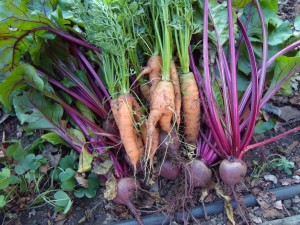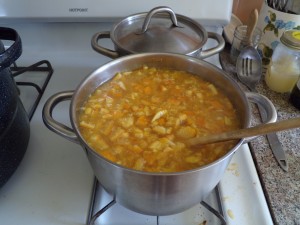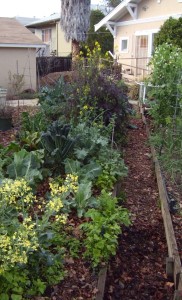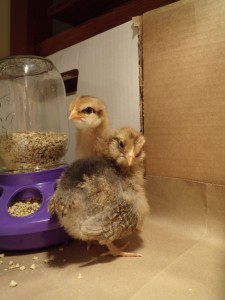What makes a hive ready to divide, and how can you, the beekeeper, tell? Here’s what I go by when deciding if one of our hives is ready to split and ready to raise its own queen. And, if any of the beekeeping jargon below has your head spinning, take a look at our illustrated glossary of beekeeping.
Population
Is the hive ‘booming’? I look for bustle at the hive entrance, including bees orienting, bees arriving at the entrance with pollen, and a generally busy, productive vibe. Removing the outer cover, I look to see if there are bees visible (teeming, even) at the inner cover’s opening. I check out how the bees’ population seems within the hive. Are the frames covered in bees? Are the boxes full?
A good strong population in and of its self doesn’t mean the hive is ready to divide, but strong numbers are a must for making a walk away split. After a divide, both the mother colony and the new split(s) need to have plenty of bees to rebuild and raise a queen.
Nectar flow
If there’s lots of new, pearly white wax in the hive and bees tending to curing honey, there is a nectar flow in progress. This bodes well for hive divisions, as it means food is plentiful. Proper nutrition is essential for the bees to be able to raise a strong new queen.
Of course, it’s entirely possible to have a nectar flow on and a hive that’s not at all ready to divide. But I would hesitate to divide a colony if I don’t see signs that the bees are finding good forage and that they are currently supplied with stores to raise a queen.
Drones
The presence of drones and drone brood within the hive generally indicates that the colony is in its reproductive phase. An exception to this is hives in which there is a drone-laying worker (this can happen when the colony lacks a queen and a worker bee begins laying unfertilized eggs). In this case, all of the brood will be drone brood—not a good sign.
In spring, in a healthy colony, the queen will begin laying some drone brood before the hive swarms. If it’s spring, and you find drones milling about in the hive and patches of drone brood on the frames, the colony is in the process of reproduction.
Capped brood
Look for a ratio of about 90% capped brood to 10% uncapped brood in the hive. This is a sign that it is definitely time to divide the hive.
Before the colony makes its final preparations for swarming, the queen’s egg production slows. The bees are actually putting her on a diet to lose weight so that she will be able to fly with the swarm when it leaves the hive. Another benefit to the slowed egg production is that capped brood is less work for the remaining bees after a swarm to care for. Since the colony remaining in the hive after a swarm has its population cut by about half, the bees can put their energy into raising a strong new queen—not feeding uncapped worker bee brood.
Queen cells
This can be an obvious sign that the colony is reproducing and will soon, or has already, swarmed. It’s also possible the colony is in the process of replacing a failing or dead queen, rather than at the height of its reproductive vigor.
If you see queen cells, check out the above indicators to confirm preparation for swarming. Also note where the queen cells are positioned on the frame. Cells along the bottom edge of the comb are more likely swarm cells, while queen cells scattered in the middle of frames are often supersedure, or queen replacement cells.
It’s also worth looking to see if you can find eggs in the hive when you see queen cells. If eggs are present (and the brood isn’t all drone) you know that the queen has been in the hive within the last three days.
Also note what stage of development the queen cell is in and how much attention the bees are paying to it. If the bees aren’t milling around over the cell and looking like they have important business to attend to, it’s likely the queen isn’t viable, or that this is an old, un-hatched queen cell. If the bees are attending to it, you should too.
The presence of viable capped swarm cells is a definitive sign that the hive has already swarmed, or that it is about to.
Case study
I inspected one of our strongest hives on March 8th. This is a colony that is seriously booming. The bees overwintered with four deep bee boxes, and we added a fifth in late February. That fifth box was teeming with bees on March 8th and was full of brood, capped honey, pollen, and nectar.
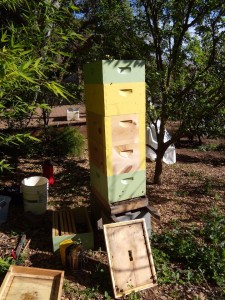
The hive last year with a honey super on top. My camera ate my recent inspection photos.
I had come prepared to divide the hive, based on its huge population. I worked my way halfway through the fifth box and considered my Is the colony ready to split? mental checklist.
Population, check. Nectar flow, check. Drones, half-check (I saw a handful of drones, as well as a handful of drone brood cells, capped and uncapped). Capped brood, no check. There was certainly capped brood, but it was nowhere near 90% of the brood I saw. I also didn’t see any queen cells.
For the record, I actually prefer to split before the bees start raising a queen. Handling frames with capped queen cells entails a risk of damaging the queen. Also, once there are queen cells, it may be too late to prevent swarming, as the first swarm may have already left with a large portion of the colony’s population.
Based on the capped brood ratio, I decided the colony wasn’t quite ready, but I thought they were close. Because of the nectar flow and the prodigiously laying queen, I added a sixth box for the colony to move into and resolved to return in a week for another inspection.
It’s amazing how different a hive can look from one week to the next when it is ramping up in spring. I ended up splitting the hive today, and am second-guessing some of my decisions, but I’ll save all that for my next post.

